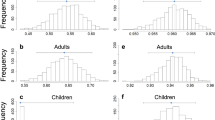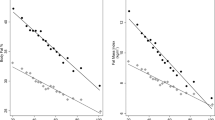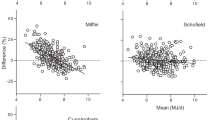Abstract
Obesity is caused by a prolonged positive energy balance1,2. Whether reduced energy expenditure stemming from reduced activity levels contributes is debated3,4. Here we show that in both sexes, total energy expenditure (TEE) adjusted for body composition and age declined since the late 1980s, while adjusted activity energy expenditure increased over time. We use the International Atomic Energy Agency Doubly Labelled Water database on energy expenditure of adults in the United States and Europe (n = 4,799) to explore patterns in total (TEE: n = 4,799), basal (BEE: n = 1,432) and physical activity energy expenditure (n = 1,432) over time. In males, adjusted BEE decreased significantly, but in females this did not reach significance. A larger dataset of basal metabolic rate (equivalent to BEE) measurements of 9,912 adults across 163 studies spanning 100 years replicates the decline in BEE in both sexes. We conclude that increasing obesity in the United States/Europe has probably not been fuelled by reduced physical activity leading to lowered TEE. We identify here a decline in adjusted BEE as a previously unrecognized factor.
This is a preview of subscription content, access via your institution
Access options
Access Nature and 54 other Nature Portfolio journals
Get Nature+, our best-value online-access subscription
$29.99 / 30 days
cancel any time
Subscribe to this journal
Receive 12 digital issues and online access to articles
$119.00 per year
only $9.92 per issue
Buy this article
- Purchase on Springer Link
- Instant access to full article PDF
Prices may be subject to local taxes which are calculated during checkout




Similar content being viewed by others
Data availability
With respect to the IAEA database and the meta-analysis of BMR data, this work comprises a secondary analysis of data that are mostly already published and available in the primary literature. These data have been compiled into a database, access to which is free. Forms for requesting data can be found at www.dlwdatabase.org and should be directed to the lead corresponding author j.speakman@abdn.ac.uk or A.J.M.-A. at a.alford@iaea.org. The BMR data are available upon request to co-corresponding author A.K. (a.kurpad@sjri.res.in). The mouse data described in the paper are available upon request to co-corresponding author M.S.R. (matthew.rodeheffer@yale.edu).
References
Hall, K. D. et al. Energy balance and body weight regulation: a useful concept for understanding the obesity epidemic. Am. J. Clin. Nutr. 95, 989–994 (2012).
Hill, J. O., Wyatt, H. R. & Peters, J. C. Energy balance and obesity. Circulation 126, 126–132 (2012).
Swinburn, B. A. et al. Obesity 1: the global pandemic: shaped by global drivers and local environments. Lancet 378, 804–814 (2011).
Church, T. S. et al. Trends over 5 decades in US occupation-related physical activity and their associations with obesity. PLoS ONE 6, e19657 (2011).
Ezzati, M. et al. Worldwide trends in body mass index, underweight, overweight and obesity from 1975 to 2016: a pooled analysis of 2416 population based measurement studies in 128.9 million children, adolescents and adults. Lancet 390, 2627–2642 (2017).
Thorp, A. A., Owen, N., Neuhaus, M. & Dunstan, D. W. Sedentary behaviours and subsequent health outcomes in adults. A systematic review of longitudinal studies, 1996–2011. Am. J. Prev. Med. 41, 207–215 (2011).
Gordon-Larsen, P., Nelson, M. C. & Popkin, B. M. Longitudinal physical activity and sedentary behavior trends—adolescence to adulthood. Am. J. Prev. Med. 27, 277–283 (2004).
Pietilainen, K. H. et al. Physical inactivity and obesity: a vicious circle. Obesity 16, 409–414 (2008).
Muller, M., Enderle, J. & Bosy-Westphal, A. Changes in energy expenditure with weight gain and weight loss in humans. Curr. Obes. Rep. 5, 413–423 (2016).
Pontzer, H. Energy constraint as a novel mechanism linking exercise and health. Physiology 33, 384–393 (2018).
Careau, V. et al. Energy compensation, adiposity and aging in humans. Curr. Biol. 31, 4659–4666.e2 (2021).
Rimbach, R. et al. Total energy expenditure is repeatable in adults but not associated with short-term changes in body composition. Nat. Commun. 13, e99 (2022).
Speakman, J. R. Doubly-Labelled Water: Theory and Practice (Springer New York, 1997).
Westerterp, K. R. & Speakman, J. R. Physical activity energy expenditure has not declined since the 1980s and matches energy expenditure of wild mammals. Int. J. Obes. 32, 1256–1263 (2008).
Speakman, J. R. et al. The IAEA international doubly-labelled water database: aims, scope and procedures. Ann. Nutr. Metab. 75, 114–118 (2019).
Speakman, J. R. et al. A standard calculation methodology for studies using doubly labeled water. Cell Rep. Med. 2, e100203 (2021).
Wardle, J., Waller, J. & Jarvis, M. J. Sex differences in the association of socioeconomic status with obesity. Am. J. Public Health 92, 1299–1304 (2002).
Lovejoy, J. C. & Sainsbury, A. Sex differences in obesity and the regulation of energy homeostasis. Obes. Rev. 10, 154–167 (2009).
Statistics on sales of home gym equipment. Statista www.statista.com (2019).
Cutler, D. M., Glaeser, E. L. & Shapiro, J. M. Why have Americans become more obese? J. Econ. Perspect. 17, 93–118 (2003).
Chau, J., Chey, T., Burks-Young, S. & Bauman, A. Trends in prevalence of leisure time physical activity and inactivity: results from Australian national health surveys 1989 to 2011. Aust. NZ J. Public Health 41, 617–624 (2017).
Vaz, M., Karaolis, N., Draper, A. & Shetty, P. A compilation of energy costs of physical activities. Public Health Nutr. 8, 1153–1163 (2005).
Protsiv, M., Ley, C., Lankaster, J., Hastie, T. & Parsonnet, J. Decreasing human body temperature in the United States since the industrial revolution. eLife 9, e49555 (2020).
Zhang, S. et al. Changes in sleeping energy metabolism and thermoregulation during menstrual cycle. Physiol. Rep. 8, e14353 (2020).
Du Bois, E. F. The basal metabolism in fever. JAMA 77, 352–355 (1921).
Yegian, A. K., Heymsfield, S. B. & Lieberman, D. E. Historical body temperature records as a population level thermometer of physical activity in the United States. Curr. Biol. 31, R1375–R1376 (2021).
Downs, C. J. et al. Selection for increased mass independent maximal metabolic rate suppresses innate but not adaptive immune function. Proc. Biol. Soc. 280, 20122636 (2013).
Buehler, D. M. et al. Independence among physiological traits suggests flexibility in the face of ecological demands on phenotypes. J. Evol. Biol. 25, 1600–1613 (2012).
Scantlebury, M. et al. Energetic costs of parasitism in Cape ground squirrel Xerus inauris. Proc. Biol. Soc. 274, 2169–2177 (2007).
Urlacher, S. S. et al. Constraint and tradeoffs regulate energy expenditure during childhood. Sci. Adv. 5, eaax1065 (2019).
Gurven, M. D. et al. High resting metabolic rate among Amazonian forager–horticulturalists experiencing high pathogen burden. Am. J. Phys. Anthropol. 161, 414–25. (2016).
Roffey, D. M., Byrne, N. M. & Hills, A. P. Day‐to‐day variance in measurement of resting metabolic rate using ventilated‐hood and mouthpiece and nose‐clip indirect calorimetry systems. J. Parenter. Enteral. Nutr. 30, 426–432 (2006).
Henry, C. J. K. Basal metabolic rate studies in humans: measurement and development of new equations. Public Health Nutr. 8, 1133–1152 (2005).
Blasbalg, T. L. et al. Changes in consumption of omega-3 and omega-6 fatty acids in the United States during the 20th century. Am. J. Clin. Nutr. 93, 950–962 (2011).
Fan, R., Koehler, K. & Chung, S. Adaptive thermogenesis by dietary n-3 polyunsaturated fatty acids: emerging evidence and mechanisms. Biochim. Biophys. Acta Mol. Cell Biol. Lipids 1864, 59–70 (2019).
Van Marken Lichtenbelt, W. D., Mansink, R. P. & Westerterp, K. R. The effect of fat composition of the diet on energy metabolism. Z. Ernahrungswiss. 36, 303–305 (1997).
Katz, M. et al. Dietary n-3-polyunsaturated fatty acids and energy balance in overweight or moderately obese men and women: a randomized controlled trial. Nutr. Metab. 6, e24 (2009).
De Meira, J. E. C. et al. Unsaturated fatty acids do not have a favourable metabolic response in overweight subjects: results of a meta-analysis. J. Funct. Foods 43, 123–130 (2018).
Haggerty, C. et al. Intra-specific variation in resting metabolic rate in MF1 mice is not associated with membrane lipid desaturation in the liver. Mech. Ageing Dev. 129, 129–137 (2008).
Brzek, P., Bielawska, K., Ksiazek, A. & Konarzewski, M. Anatomic and molecular correlates of divergent selection for basal metabolic rate in laboratory mice. Physiol. Biochem. Zool. 80, 491–499 (2007).
McGill, C. R. et al. Ten-year trends in fiber and whole grain intakes and food sources for the United States population: national health and nutrition examination survey 2001–2010. Nutrients 7, 1119–1130 (2015).
Karl, J. P. et al. Substituting whole grains for refined grains in a 6-wk randomized trial favorably affects energy-balance metrics in healthy men and postmenopausal women. Am. J. Clin. Nutr. 105, 589–599 (2017).
Speakman, J. R. & Pontzer, H. Quantifying physical activity energy expenditure based on doubly-labelled water and basal metabolism calorimetry: what are we actually measuring? Curr. Opin. Clin. Nutr. Metab. Care (in the press).
Weir, J. B. New methods for calculating metabolic rate with special reference to protein metabolism. J. Physiol. 109, 1–9 (1949).
Wang, Z. M. et al. Hydration of fat-free body mass: review and critique of a classic body composition constant. Am. J. Clin. Nutr. 69, 833–841 (1999).
Pontzer, H. et al. Daily energy expenditure through the human life course. Science 373, 808–812 (2021).
Camps, S. G., Verhoef, S. P. & Westerterp, K. R. Weight loss-induced reduction in physical activity recovers during weight maintenance. Am. J. Clin. Nutr. 98, 917–923 (2013).
Rudolph, M. C. et al. Thyroid hormone responsive protein Spot14 enhances catalysis of fatty acid synthase in lactating mammary epithelium. J. Lipid Res. 55, 1052–1065 (2014).
Rudolph, M. C. et al. Mammalian fatty acid synthase activity from crude tissue lysates tracing (1)(3)C-labeled substrates using gas chromatography–mass spectrometry. Anal. Biochem. 428, 158–166. (2012).
Acknowledgements
The authors gratefully acknowledge funding to directly support this work as well as funding for the original studies that contributed to the database that are not listed individually here. In particular, direct support grants CAS 153E11KYSB20190045 from the Chinese Academy of Sciences to J.R.S. and grant BCS-1824466 from the National Science Foundation of the United States to H.P. are gratefully acknowledged. The mouse work was supported by grants from the Swedish Research Council International Postdoctoral Fellowship (VR 2018-06735) to J.M.A.J., National Institutes of Health grants K01DK109079 and R03DK122189 to M.C.R. and grants R01DK090489 and R01DK126447 to M.S.R. A.K. is supported by the IA/CRC/19/1/610006 grant from the DBT-Wellcome Trust India Alliance. We are grateful to T. Goodrich for comments on earlier drafts of the manuscript. The DLW database, which can be found at https://www.dlwdatabase.org/, is also generously supported by the IAEA, Taiyo Nippon Sanso and SERCON. We are grateful to these companies for their support and especially to T. Oono of Taiyo Nippon Sanso. The funders played no role in the content of this manuscript. Individuals who submitted data to the database that were not used in the analysis in this paper are listed in Supplementary Information (part 3). We are grateful for their contribution to the database.
Author information
Authors and Affiliations
Contributions
J.R.S., K.R.W. and L.G.H. processed and analysed the IAEA data. J.M.A.d.J., J.L.K. and M.C.R. collected, processed and analysed the mouse data. S.S., S.G., J.R.S. and A.K. collected and analysed the retrospective BMR data from the literature. J.R.S., K.R.W., Y.Y., H.S., P.N.A., L.J.A., L.A., K.B.-A., S. Blanc, A.G.B., P.B., S. Brage, M.S.B., N.F.B., S.G.J.A.C., J.A.C., R.C., S.K.D., L.R.D., P.S.W.D., U.E., S.E., T.F., B.W.F., M. Gillingham, A.H.G., M. Gurven, C.H., H.H.H., D.H., S.H., A.M.J., P.K., W.E.K., R.F.K., W.R.L., M.L., A.H.L., C.K.M., E.M., A.C.M., E.P.M., J.C.M., J.P.M., M.L.N., T.A.N., R.M.O., H.P., K.H.P., J.P.-R., G.P., R.L.P., S.B. Racette, D.A.R., E.R., L.M.R., J.R., S.B. Roberts, L.B.S., D.A.S., A.J.S., A.M.S., E.S., S.S.U., G.V., L.M.v.E., E.A.v.M., B.M.W., W.W.W., J.A.Y., T.Y. and X.Z. contributed data to the database. J.R.S, Y.Y., H.S., S.S., A.J.M.-A., C.U., A.H.L., H.P., J.R., D.A.S. and W.W.W. created, curated and administered the database.
Corresponding authors
Ethics declarations
Competing interests
The authors have no conflicts of interest to declare.
Peer review
Peer review information
Nature Metabolism thanks the anonymous reviewers for their contribution to the peer review of this work. Primary Handling Editor: Isabella Samuelson, in collaboration with the Nature Metabolism team.
Additional information
Publisher’s note Springer Nature remains neutral with regard to jurisdictional claims in published maps and institutional affiliations.
Extended data
Extended Data Fig. 1 Representativeness of the IAEA database dataset included in the analysis.
Distribution of BMI in the sample data for a) females and b) males. Trends in body weight over the interval from 1982 to 2017 for c) males and d) females. There was a significant increase in weight over time in both sexes. For males (gradient = 0.015 kg/month F = 7.04, p = 0.009) reflecting an average weight increase of 5.4 kg over 30 years, and for females (gradient = 0.023 kg/month F 20.84, p = 0.000005) reflecting an average increase of 8.3 kg over 30 years.
Extended Data Fig. 2 Trends over time in unadjusted total, basal and activity energy expenditure in males.
Trends over time in a) unadjusted total energy expenditure, b) unadjusted basal energy expenditure, and c) unadjusted activity energy expenditure for males. All expenditures are in MJ/d and time is expressed in months since January 1982. Significant years are also indicated. Each data point is a different measurement of expenditure. The red lines are the fitted least squares regression fits. For regression details refer to text and Table 1.
Extended Data Fig. 3 Trends over time in unadjusted total, basal and activity energy expenditure in females.
Trends over time in a) unadjusted total energy expenditure, b) unadjusted basal energy expenditure, and c) unadjusted activity energy expenditure for females. All expenditures are in MJ/d and time is expressed in months since January 1982. Significant years are also indicated. Each data point is a different measurement of expenditure. The red lines are the fitted least squares regression fits. For regression details refer to text and Table 1.
Extended Data Fig. 4 Relationships of unadjusted total, basal and activity energy expenditure to body mass index in both males and females.
Relationships between energy expenditure parameters and Body mass index (BMI). In females the relationships were: a) for TEE vs BMI (F = 559.3, p < 10-16), c) BEE vs BMI (F = 242.6, p < 10-16), e) AEE vs BMI (F = 45.13, p < 10-10). For males the relationships were: b) for TEE vs BMI (F = 114.6, p < 10-16), d) BEE vs BMI (F = 79.4, p < 10-16), f) AEE vs BMI (F = 16.28, p = 6 ×10−5).
Extended Data Fig. 5 Trends over time in physical activity level in both males and females.
Trends over time in Physical Activity Level (PAL = TEE/BEE). PAL is dimensionless and time is expressed in months since January 1982. Significant years are also indicated. a) is for males and b) is for females. The red lines are the fitted least squares regression fits. For regression details refer to text.
Extended Data Fig. 6 Search strategy for systematic review.
Systematic review strategy. Flow diagram for selection of studies according to PRISMA guidelines.
Supplementary information
Supplementary Information
Materials and methods, Supplementary Tables 1–4 and group authorship details.
Rights and permissions
Springer Nature or its licensor (e.g. a society or other partner) holds exclusive rights to this article under a publishing agreement with the author(s) or other rightsholder(s); author self-archiving of the accepted manuscript version of this article is solely governed by the terms of such publishing agreement and applicable law.
About this article
Cite this article
Speakman, J.R., de Jong, J.M.A., Sinha, S. et al. Total daily energy expenditure has declined over the past three decades due to declining basal expenditure, not reduced activity expenditure. Nat Metab 5, 579–588 (2023). https://doi.org/10.1038/s42255-023-00782-2
Received:
Accepted:
Published:
Issue Date:
DOI: https://doi.org/10.1038/s42255-023-00782-2
This article is cited by
-
Determinants of obesity in Latin America
Nature Metabolism (2024)



